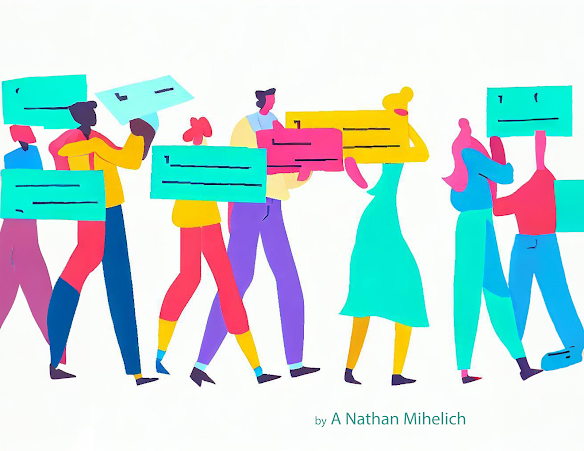Embracing Digital Transformation: A Psychological Perspective on Dues Collection for Association Volunteers
In small associations, volunteers often shoulder the significant responsibility of managing various tasks, from driving membership growth to organizing events. One of these critical yet challenging tasks is dues collection. Traditional methods like cash or check payments have been common, but they can impose a considerable psychological burden on these unsung heroes. In this era of technological advancement, it is worth examining the psychological aspects that underpin dues collection and the tremendous benefits that electronic payment methods can offer.
The Struggle of Traditional Collection Methods: A Psychological Toll on Volunteers
Collecting dues in the form of cash or checks from members is not merely a financial transaction; it's an activity fraught with emotional and psychological undertones. This method demands substantial time and energy, leaving volunteers with less time for strategic tasks that could significantly contribute to the association's growth.
The recurring cycle of asking members for dues, particularly when they're overdue, can stir feelings of unease and discomfort in volunteers. This task, often likened to debt collection, can induce stress and anxiety, causing a ripple effect on their morale and performance.
Moreover, manual collection is prone to human error, which could lead to miscounting or misplacement of funds. These instances not only disrupt the association's financial records but also sow seeds of guilt and self-doubt in volunteers, affecting their overall emotional well-being.
The Resistance to Change: Understanding the Naysayers
Despite the clear drawbacks of traditional dues collection, some individuals resist the transition to digital payment methods. This resistance typically stems from a sense of familiarity with traditional methods and fear or mistrust of new technology.
There is a certain comfort derived from the tangibility of cash and checks, providing a sense of control and perceived security. Some individuals also believe in the personal touch these methods offer, as they involve direct interactions.
However, this resistance to digital transformation could significantly hamper the progress and efficiency of associations. By clinging to outdated methods, naysayers may unintentionally impede the organization's potential to innovate, grow, and adapt to the needs of a digitally inclined membership.
The Shift to Electronic Payment: Unleashing a Sea of Benefits
Moving to electronic dues collection is not merely a process upgrade—it's a transformative step towards boosting efficiency, reducing stress, and revitalizing volunteer engagement.
Time-Saving and Productivity: Digital payment platforms streamline the collection process, allowing volunteers to process payments swiftly with a few clicks. This saves precious time that can be redirected towards more strategic tasks, boosting overall productivity.
Stress Reduction: By automating dues collection, volunteers can avoid the uncomfortable task of chasing members for payments. This can significantly reduce stress and anxiety associated with the collection process, fostering a healthier emotional environment for volunteers.
Improved Accuracy and Security: Digital payments ensure accurate, real-time tracking of all transactions, reducing the likelihood of errors or misplacement. Additionally, the use of secure payment gateways protects against fraud, contributing to volunteers' peace of mind.
Enhanced Member Satisfaction: A quick, easy, and secure payment process improves the member experience, leading to increased satisfaction and loyalty. The positive feedback and success stories can uplift the spirits of volunteers, fueling their motivation and commitment.
The Path Forward
Change can be challenging and may meet with resistance, but embracing digital transformation for dues collection is a change worth championing. While some members may prefer traditional methods, it's crucial to emphasize the benefits of electronic payments—saving time, reducing stress, improving accuracy, and enhancing member satisfaction.
Naysayers need to understand that resisting this change could limit the organization's potential to grow, innovate, and meet the changing needs of its members. Volunteers, as the backbone of small associations, deserve systems that respect theireffort, time, and emotional well-being. By making the shift to digital dues collection, associations not only promote operational efficiency but also contribute to a more positive and productive environment for their volunteers.
Workshops and training sessions could be conducted to ease the transition process, ensuring volunteers and members alike are comfortable with the new system. Associations should also maintain open communication to address concerns and resistance that may arise during the transition.
Ultimately, adopting electronic dues collection is a strategic move towards a more sustainable future for associations. It marks a step forward in acknowledging and addressing the psychological impact of traditional dues collection on volunteers. By doing so, associations ensure they are not just keeping up with the times, but also fostering an environment where their volunteers can thrive without unnecessary stress. The cost of resisting this change could be high, potentially stagnating the association's progress and growth.
Therefore, it's time to embrace the wave of digital transformation. By adopting electronic dues collection, associations will not only streamline their operations but also show their appreciation for the invaluable contributions of their volunteers, creating a win-win scenario for everyone involved. It's a change that warrants serious consideration and quick action for the benefit of all stakeholders. The future of small associations depends on making wise choices today. Embrace digital dues collection for a thriving, stress-free tomorrow.
By A. Nathan Mihelich




Comments
Post a Comment